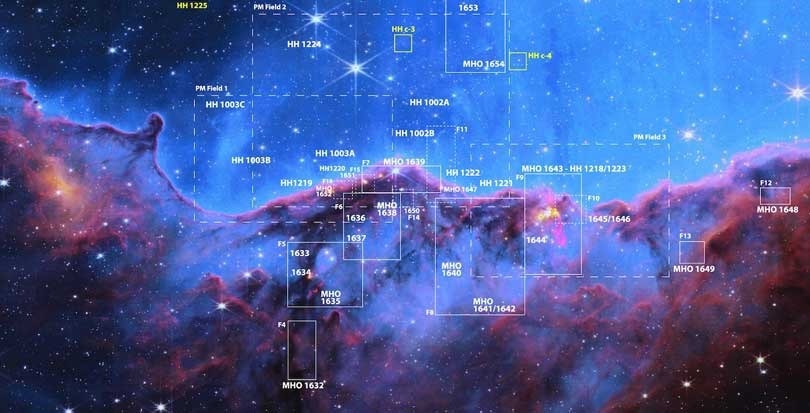Megan Reiter of Rice University and colleagues did a “deep dive” into one of the first images from NASA’s James Webb Space Telescope and were surprised to find unmistakable indications from two dozen previously undiscovered young stars 7,500 light years away.

Astronomers from Rice University and other organizations dug deep into the data from this near-infrared image, one of the first taken by NASA’s James Webb Space Telescope. The image shows a star-forming region in the constellation Carina known as the Cosmic Cliffs. Many newborn stars in such regions are shrouded in thick clouds of dust. Webb’s infrared camera penetrated the dust, allowing astronomers to discover telltale signs of two dozen infant stars that had not been previously detected. Image Credit: NASA, ESA, CSA, and STScI.
The finding, which was published in the December issue of the Monthly Notices of the Royal Astronomical Society, provides a preview of what astronomers will discover with Webb's near-infrared camera. The gadget is intended to peek through clouds of interstellar dust that formerly obscured astronomers’ views of stellar nurseries, particularly those that create stars similar to the sun.
A part of Webb’s initial images of the Cosmic Cliffs, a star-forming region in the NGC 3324 star cluster, were examined by Reiter, an assistant professor of physics and astronomy, and co-authors from the California Institute of Technology, the University of Arizona, Queen Mary University in London, and the Royal Observatory in Edinburgh, Scotland.
What Webb gives us is a snapshot in time to see just how much star formation is going on in what may be a more typical corner of the universe that we haven’t been able to see before.
Megan Reiter, Assistant Professor, Physics and Astronomy, Rice University
NGC 3324, which is in the southern constellation Carina, is home to numerous well-known star-forming regions that have been extensively studied by astronomers for many years. Many characteristics in the region have been hidden by dust in Hubble Space Telescope and other observatories’ images. Webb’s infrared camera was designed to look through the dust in such areas and identify gas and dust jets that burst from the poles of very young stars.
Reiter and coworkers concentrated their efforts on a region of NGC 3324 where just a few young stars had earlier been discovered. They detected two dozen previously unrecognized outflows of molecular hydrogen from young stars by examining a specific infrared wavelength, 4.7 microns. The amount of the outflows vary, but many appear to originate from protostars that will ultimately become low-mass stars like the sun.
The findings speak both to how good the telescope is and to how much there is going on in even quiet corners of the universe.
Megan Reiter, Assistant Professor, Physics and Astronomy, Rice University
Newborn stars collect material from the gas and dust around them over their first 10,000 years. Many young stars release a fraction of that material back into space via jets that blast out from their poles in opposite directions. Dust and gas accumulate in front of the jets, which plow through the nebular clouds like snowplows. Molecular hydrogen, a critical component of young stars, is swept up by these jets and seen in Webb’s infrared images.
Jets like these are signposts for the most exciting part of the star formation process. We only see them during a brief window of time when the protostar is actively accreting.
Nathan Smith, Study Co-Author, University of Arizona
Due to its short duration—typically just a few thousand years at the initial stage of a star’s multimillion-year childhood—the accretion period of early star formation has proven particularly challenging for astronomers to examine.
Jets like those observed in the study, according to study co-author Jon Morse of the California Institute of Technology, “are only visible when you embark on that deep dive—dissecting data from each of the different filters and analyzing each area alone. It’s like finding buried treasure.”
According to Reiter, the magnitude of the Webb telescope also had a role in the discovery.
Reiter adds, “It’s just a huge light bucket. That lets us see smaller things that we might have missed with a smaller telescope. And it also gives us really good angular resolution. So we get a level of sharpness that allows us to see relatively small features, even in faraway regions.”
NASA leads the Webb Space Telescope program in collaboration with the European Space Agency (ESA) and the Canadian Space Agency (CSA). The telescope’s science and mission operations are headed by the Space Telescope Science Institute (STScI) in Baltimore.
The study was funded by NASA (NAS 5-0312, NAS 5–26555), STScI, and a Dorothy Hodgkin Fellowship from the UK’s Royal Society.
Journal Reference
Reiter, M., et al. (2022) Deep diving off the ‘Cosmic Cliffs’: previously hidden outflows in NGC 3324 revealed by JWST. Monthly Notices of the Royal Astronomical Society. doi.org/10.1093/mnras/stac2820.